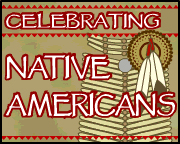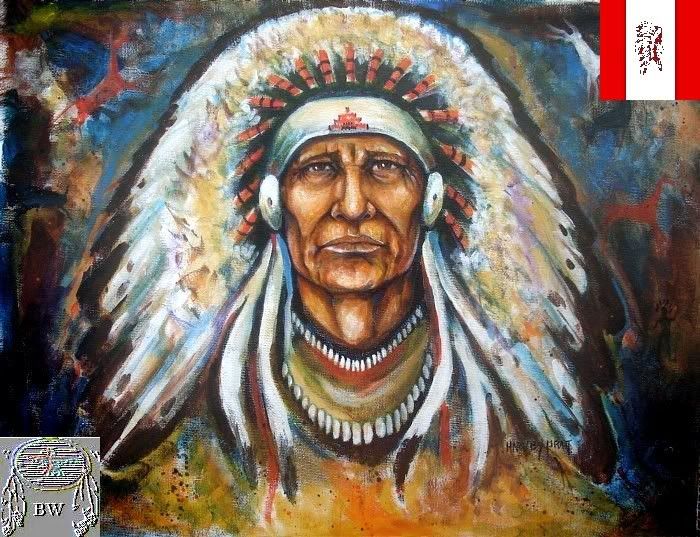|
BRAVEHORSE WARRIOR Glikhikan
Delaware Warrior

 Chief Glikhikan
Warrior Citation
GLIKHIKAN (Glickhican, usually translated as gun sight or sight on a gun barrel; baptized Isaac), Munsee Delaware warrior
and orator, Moravian convert and “native elder”; probably b. c. 1730 in Pennsylvania; d. 8 March 1782 at Gnadenhutten
(Ohio). An eminent Delaware war captain, Glikhikan journeyed to Canada in support of the French during the Seven Years’
War. In 1763 he participated in the siege of Fort Pitt (Pittsburgh, Pa) during Pontiac’s uprising. He was the most influential
counsellor to Packnake, head chief of the Munsee Delawares at Kuskuski (near New Castle, Pa). An early opponent of Christianity,
Glikhikan had contested the efforts of the Jesuits among the tribes bordering on lakes Erie and Ontario. In 1769 he journeyed
to the new Moravian mission at Lawunakhannek (near Franklin, Pa), intending to force David Zeisberger and other missionaries
from the region. While at Lawunakhannek, he listened to Zeisberger preach and soon was converted to Christianity. During the
following year he was instrumental in extending the Delaware invitation to the Moravians to establish a new mission, Languntoutenünk
(probably near Darlington), on the Beaver River in western Pennsylvania. On Christmas Eve 1770 he was baptized into the Moravian
congregation there. Glikhikan remained a dedicated Christian and assisted Zeisberger and John Gottlieb Ernestus Hackenwelder
(Heckewelder) in their attempts to spread the Moravian faith among the tribes of the Ohio valley. Glikhikan’s former
stature as an orator and warrior enabled him to exert considerable influence, and he soon became a “national helper”
or “native elder.” In 1772 he and the Moravian Native Americans moved to the present Tuscarawas River in eastern
Ohio, where they founded two new settlements: Schoenbrunn (near New Philadelphia) and Gnadenhutten.
Chief Glikhikan
Warrior Citation
GLIKHIKAN (Glickhican, usually translated as gun sight or sight on a gun barrel; baptized Isaac), Munsee Delaware warrior
and orator, Moravian convert and “native elder”; probably b. c. 1730 in Pennsylvania; d. 8 March 1782 at Gnadenhutten
(Ohio). An eminent Delaware war captain, Glikhikan journeyed to Canada in support of the French during the Seven Years’
War. In 1763 he participated in the siege of Fort Pitt (Pittsburgh, Pa) during Pontiac’s uprising. He was the most influential
counsellor to Packnake, head chief of the Munsee Delawares at Kuskuski (near New Castle, Pa). An early opponent of Christianity,
Glikhikan had contested the efforts of the Jesuits among the tribes bordering on lakes Erie and Ontario. In 1769 he journeyed
to the new Moravian mission at Lawunakhannek (near Franklin, Pa), intending to force David Zeisberger and other missionaries
from the region. While at Lawunakhannek, he listened to Zeisberger preach and soon was converted to Christianity. During the
following year he was instrumental in extending the Delaware invitation to the Moravians to establish a new mission, Languntoutenünk
(probably near Darlington), on the Beaver River in western Pennsylvania. On Christmas Eve 1770 he was baptized into the Moravian
congregation there. Glikhikan remained a dedicated Christian and assisted Zeisberger and John Gottlieb Ernestus Hackenwelder
(Heckewelder) in their attempts to spread the Moravian faith among the tribes of the Ohio valley. Glikhikan’s former
stature as an orator and warrior enabled him to exert considerable influence, and he soon became a “national helper”
or “native elder.” In 1772 he and the Moravian Native Americans moved to the present Tuscarawas River in eastern
Ohio, where they founded two new settlements: Schoenbrunn (near New Philadelphia) and Gnadenhutten.
 During Lord Dunmore’s War (between Virginia and the Shawnees in 1774), Glikhikan assisted the Delaware chief White
Eyes in keeping his tribe out of the conflict, and when the American revolution erupted, he used his influence to prevent
large numbers of Delawares from joining the British. Although the Moravian villages proclaimed neutrality, the missionaries
and the converts favored the Americans and occasionally supplied American leaders at Pittsburgh with intelligence of British
raiding parties. Between 1777 and 1781 Glikhikan successfully persuaded several groups of pro-British Native Americans who
were passing through the Moravian towns to return to their villages without striking the Americans. He also protected Zeisberger
and other missionaries from hostile warriors. In September 1781 a large British war party led by Matthew Elliott, the Wyandot
chief Pomoacan (Half-King), and the Delaware chief Konieschguanokee (Captain Pipe) forced Glikhikan, the missionaries, and
the Moravians to abandon their settlements in the Tuscarawas valley and resettle at Captives’ Town on the upper Sandusky
River. During late October Glikhikan, Zeisberger, Hackenwelder, and several of the Moravians journeyed to Detroit, where they
were interrogated by the British commander, Major Arent Schuyler De Peyster. De Peyster found them innocent of the charges
that they had actively aided the Americans, and in November 1781 Glikhikan and the missionaries returned to Captives’
Town. During the winter of 1781–82 the refugees on the Sandusky suffered from a severe shortage of food. In February
1782 Glikhikan led about 100 of the Native Americans back to the Tuscarawas towns, hoping to harvest the corn they had been
forced to abandon the previous September. At Gnadenhutten, Glikhikan and his followers were surprised by a force of Pennsylvania
militia commanded by Lieutenant-Colonel David Williamson. The Pennsylvanians accused the Moravians of supporting the British,
and on 8 March 1782 Glikhikan, his wife Anna, and 88 others died under the hatchets and mallets of the Americans. From: historical
accounts & records
During Lord Dunmore’s War (between Virginia and the Shawnees in 1774), Glikhikan assisted the Delaware chief White
Eyes in keeping his tribe out of the conflict, and when the American revolution erupted, he used his influence to prevent
large numbers of Delawares from joining the British. Although the Moravian villages proclaimed neutrality, the missionaries
and the converts favored the Americans and occasionally supplied American leaders at Pittsburgh with intelligence of British
raiding parties. Between 1777 and 1781 Glikhikan successfully persuaded several groups of pro-British Native Americans who
were passing through the Moravian towns to return to their villages without striking the Americans. He also protected Zeisberger
and other missionaries from hostile warriors. In September 1781 a large British war party led by Matthew Elliott, the Wyandot
chief Pomoacan (Half-King), and the Delaware chief Konieschguanokee (Captain Pipe) forced Glikhikan, the missionaries, and
the Moravians to abandon their settlements in the Tuscarawas valley and resettle at Captives’ Town on the upper Sandusky
River. During late October Glikhikan, Zeisberger, Hackenwelder, and several of the Moravians journeyed to Detroit, where they
were interrogated by the British commander, Major Arent Schuyler De Peyster. De Peyster found them innocent of the charges
that they had actively aided the Americans, and in November 1781 Glikhikan and the missionaries returned to Captives’
Town. During the winter of 1781–82 the refugees on the Sandusky suffered from a severe shortage of food. In February
1782 Glikhikan led about 100 of the Native Americans back to the Tuscarawas towns, hoping to harvest the corn they had been
forced to abandon the previous September. At Gnadenhutten, Glikhikan and his followers were surprised by a force of Pennsylvania
militia commanded by Lieutenant-Colonel David Williamson. The Pennsylvanians accused the Moravians of supporting the British,
and on 8 March 1782 Glikhikan, his wife Anna, and 88 others died under the hatchets and mallets of the Americans. From: historical
accounts & records
|

